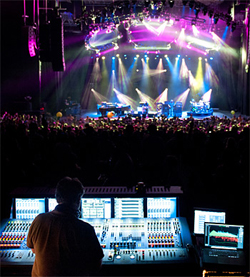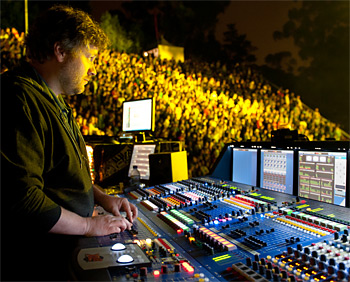Phish is a band with a reputation for incredible live performances, something house sound engineer Garry Brown takes very seriously.
Brown started mixing for Phish guitarist Trey Anastasio’s band in 2006, moving into Phish’s mixing chair when the band re-formed in 2009.
In order to improve the group’s live sound, Brown switched to Midas digital mixing consoles prior to a 3-week run with Anastasio in February 2010.
“I had been using a couple of other digital desks, but was never totally sold on the sound,” says Brown.
“I had always loved the Midas analog sound, so I thought I’d give their digital consoles a try.”
Prior to the tour, Brown spent a few days test-driving, first the XL8 in England, then the PRO6 at Eighth Day Sound in Cleveland.
“I found both consoles to be relatively easy to learn,” he said. “The PRO Series is a lot simpler than the XL8, but they are based on the same concepts, so they’re very similar.”
“The XL8 in particular has an analog feel, but both are very accessible.”
When Phish announced its summer tour plans, Brown made immediate plans to bring the XL8. “With its physical layout, the XL8 has a more analog operational feel, which is great,” said Brown.
“The POP Groups are great. They make moving around the console a breeze,” he continues. “My VCAs are set up in my normal way, with keyboards split over multiple VCAs.”
“The POP Groups are set up to view instruments by band member. I’ve also got all playback, audience mics and effects assigned to other POP Groups. It really makes navigation of all the inputs incredibly simple.”
As for his overall experience on both the Midas PRO6 and XL8, Garry Brown is convinced he made the right choice.
“The consoles themselves are great, both in terms of operation and, more importantly, sound quality. Everything I’ve been trying to get back into my sound since going digital, the Midas has it. It’s a bit cliché, but I’m home!”
“Learning the signal routing was actually the biggest challenge for me,” Brown said. “But once you get your head around the patch page, it’s very easy to patch and repatch channels as needed.”
“On Trey’s February run with the PRO6, the internal FX proved themselves more than worthy of use. But when switching to the XL8 for summer touring with Phish, I decided to carry a computer for use with Pro Tools and Waves,” he said.
“For effects, I’m using the Lynx AES16e-50 interface, running Waves Multirack software. It runs flawlessly.”
Brown is especially fond of the XL8’s KVM switch, which allows him to display the Waves software directly on any one of the console’s five hi-contrast video display screens.
“The lighting guys actually complained about how bright they are, but then they noticed that during the day, even in direct sunlight, the XL8 screens are still visible, while the lighting console screens are washed out,” said Brown with a chuckle.
Of the five screens on the XL8, Brown keeps three in default mode, displaying input channels and meters, while another displays the system’s status page.
“I’ve used a lot of digital consoles, and I think you get used to the sound over time, maybe even changing your expectations,” said Brown. “But the first time I used Midas digital, the sound quality just blew me away.”





















